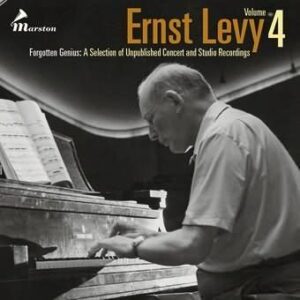The fourth double-CD release in the Marston label’s series devoted to Ernst Levy presents live performances of works all new to the Swiss pianist/composer’s discography, plus extremely rare 1953 studio recordings of Beethoven’s Op. 109 and Liszt’s B minor sonata. Although the latter two purport to be unpublished, my college library actually had an LP on the Omega label containing these very performances, one on each side, in a plain white sleeve. Although I lost the reel-to-reel tape that I made from this horribly scratched-up LP copy, I correctly remembered the interpretations as being slightly different in detail from their counterparts on the Unicorn label, though interpretively similar.
In both instances Levy unravels Op. 109’s first movement slowly and arguably pedantically, although the 1953 Scherzo’s transitional left-hand broken octaves are a shade more muted and mysterious. By contrast, the third movement’s brisk Variation III proves somewhat cleaner and crisper in 1956, yet both third-movement recordings feature a mesmerizing, Schnabel-like breadth and repose in the theme and Variations I, II, and VI.
The 1956 Liszt sonata’s liberal tempo fluctuations, harmonic pointing of virtuosic passages (the unison octaves), and heavily underlined voicings in the Fughetta are present in 1953 but less exaggerated, which accounts for the earlier performance’s shorter total duration. The live Haydn sonatas fare best in the dramatic, imaginatively-timed slower movements and worst in the often slapdash, hard driven Allegros.
In contrast to the Schubert A major D. 664 sonata’s transparency and poetic lilt, Levy pulls out all of the Romantic stops in Franck’s Prelude, Chorale, and Fugue. Shapely, booming bass lines provide the Prelude’s flowing impetus, and if the Chorale’s chordal climaxes peak too soon, the Fugue’s combination of unstoppable momentum and deft contrapuntal juggling left me emotionally drained yet curiously surprised at the audience’s tepid reaction.
A similar but more controlled approach characterizes Levy’s big boned, rhetorical readings of Brahms’ Op. 79 Rhapsodies. However, to hear Levy really let loose in front of an audience, check out Liszt’s B minor Ballade, where Levy’s epic drama, whipped-up tempos, and huge sonorities fill the performing space without smothering it. Imagine Horowitz’s febrile temperament, Arrau’s full-bodied textures, and Nyiregyházi’s divine madness all rolled into one piano player for 16 intense, unbelievable minutes.
The booklet notes include a brief biography of the pianist, excerpts from Levy’s own writings, and an extended memoir by his composer/cellist son Frank Ezra Levy. Thanks to Ward Marston and his production team for continuing their advocacy of this formidable and fascinating musician.
































